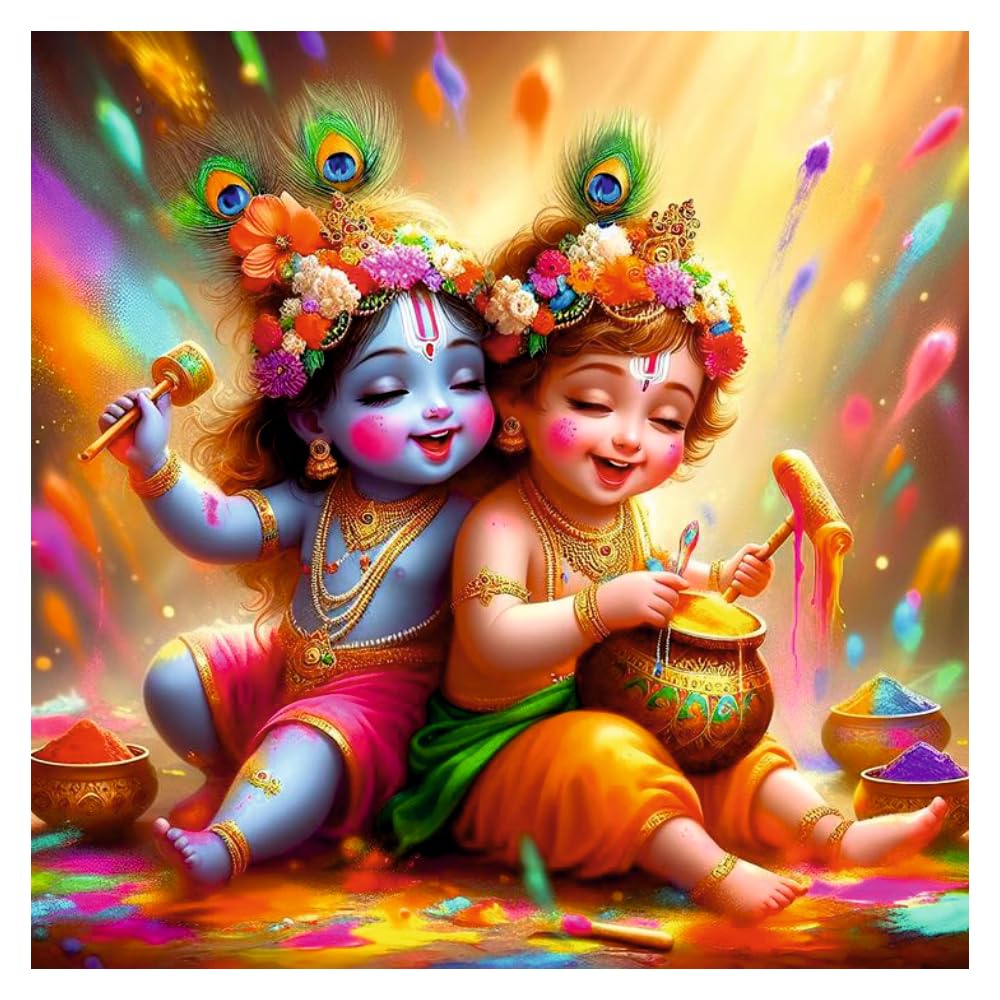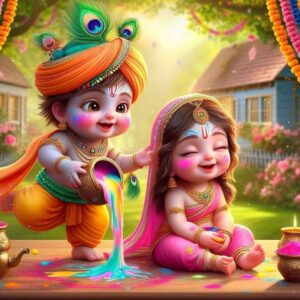🌼 Holi or Dhuleti 🌼

॥ ॐ श्री परमात्मने नमः ॥
🚩 Holi 2025 🚩

History of Holi:
In ancient India, Hiranyakashipu was a demon-like monarch. He desired to exact revenge for Lord Vishnu’s murder of his younger brother. Thus, the monarch prayed for years to become powerful. At last, he received a boon. As a result, Hiranyakashipu began to regard himself as God and urged his subjects to worship him as such.
Prahalad, the young son of the cruel king, was a devoted follower of Lord Vishnu. Prahalad continued to worship Lord Vishnu despite his father’s orders. Because his son refused to worship him, the ruthless king chose to murder him.
He requested that his fire-impervious sister, “Holika,” sit on a fire pyre while holding Prahalad on her lap. They intended to set Prahalad on fire. However, their scheme failed when someone burned Holika to ashes, but Prahalad, who was saying the name of Lord Vishnu the entire time, stayed safe.
Holika’s defeat represents the destruction of everything negative. Lord Vishnu then murdered Hiranyakashipu. In reality, however, Holi connects to the death of Holika. In order to commemorate the death of evil, people start a bonfire pyre the day before Holi in various Indian states, such as Bihar.
However, what role did colors play in Holi? This is from the time of Lord Krishna, who was Lord Vishnu’s rebirth. It is thought that Lord Krishna popularized the use of color in Holi celebrations. He used to go to Vrindavan and Gokul to play Holi with his pals. They turned this into a community event since they used to pull practical jokes all over the village. For this reason, Vrindavan’s Holi celebrations remain unparalleled to this day.
People celebrate Holi in the spring to bid winter farewell. In many regions, the festivities also connect to the spring harvest. Farmers celebrate Holi as part of their joy after they witness their stockpiles replenished with fresh harvests. Because of this, people also know Holi as ‘Vasant Mahotsava’ and ‘Kama Mahotsava.’
***
🕰️ Holi 2025 Date & Time:📅
Holi on Friday, March 14, 2025.
Holika Dahan on Thursday, March 13, 2025.
Purnima Tithi Begins—10:35 on Mar 13, 2025.
Purnima Tithi Ends—12:23 on Mar 14, 2025.
***
💐Significance Of Holika Dahan💐
An important Hindu holiday that people observe annually is Holika Dahan. It honors the tale of Prahlad, a devout devotee of Lord Vishnu, who his malevolent aunt Holika spared from murder. People celebrate the festival by lighting a bonfire, and they gather around it to offer prayers and sing devotional songs. The burning serves as a reminder that righteousness and truth will always prevail and represents the triumph of good over evil.
***
🍀 Holika Dahan Puja Vidhi:🍀
To worship Holika Dahan, it is necessary to take a bath first.
After bathing, sit facing north or east at the place of Holika’s worship.
To worship, make an idol of Holika and Prahlad from cow dung.
For the worship material, keep roli, flowers, garland of flowers, raw thread, jaggery, whole turmeric, moong, batasha, gulal coconut, 5 to 7 types of grains, and water in a pot.
After this, use all these worship materials to worship with full rituals. Offer sweets and fruits.
Along with the worship of Holika, worship Lord Narasimha with rituals and then circumambulate seven times around Holika.
***
🌻Benefits of the Holi festival 🌻
The Holi festival is known for its vibrant colors, lively music, and joyous celebrations. But did you know that it also has several health and social benefits? Here are some of the benefits of the Holi festival:
Promotes social harmony and unity: Regardless of caste, creed, or socioeconomic standing, people gather during Holi to rejoice and have fun. As everyone forgets their differences and joins in the celebration, the festival fosters social harmony and unity.
Reduces stress and anxiety: The relaxing effects of Holi’s colors and music can lower tension and anxiety levels in both the body and the psyche. The festival makes it possible to enjoy some pleasure and leisure while taking a vacation from the everyday grind.
Boosts immunity: The immune system can benefit from color and water play because it promotes the formation of antibodies and white blood cells.You can further increase immunity by indulging in nutritious foods and beverages during the festival.
Improves cardiovascular health: Holi’s dancing and physical activities can benefit cardiovascular health by increasing blood flow, lowering blood pressure, and lowering the risk of heart disease.
Promotes self-expression and creativity: As individuals come up with inventive methods to play with colors and water, Holi is a time for self-expression and creativity. Because it enables people to express themselves freely and creatively, this can have a positive impact on mental health.
Builds relationships and strengthens bonds: As people visit their friends and relatives and give gifts and sweets, Holi is a time to solidify friendships and form new ones. Because it promotes a feeling of belonging and community, this can benefit mental and emotional health.
Celebrates the arrival of spring: Holi heralds the start of spring, a season of rebirth and development. The festival honors the beauty and abundance of nature while serving as a reminder of how crucial it is to coexist peacefully with the environment.
***
🌻 Do’s and Don’ts on Holi and Dhuleti: 🌻
Don’t hurt the animals around you:
On Holi, our four-legged companions who have taken up residence on our streets have nowhere to go. Let’s use caution to prevent their bodies from absorbing the poisonous color that we voluntarily put on ourselves.
After playing, you’re going to wash off the pollutants at home. They will either leave it on and allow it to impact their skin or attempt to lick it off themselves. They stand to lose in any scenario.
Don’t waste water:
They say future wars will be fought for water. Let’s postpone that day as much as possible. All we need to do is say no to pichkaris. A dry Holi can be a great Holi too!
Do not use Holi as an excuse to run your hands over people:
Consent first. Always. Let’s make Holi fun for everyone. Let this festival of color truly be a colorful experience and not where dark, haunting memories are created.
Do not force people to play Holi:
The poster below says it all. ‘Bura na mano, Holi hain,’ but if people are inconsiderate, feeling bad about Holi is inevitable.
Do’s:
Play with people who are willing to play
Protect your eyes, nose, and ears
Apply coconut, olive, or mustard oil to your skin and hair before playing
Stay hydrated
Use a water gun instead of throwing water balloons
Enjoy homemade sweets
Sing, dance, and exchange stories
***
🍀 Celebration of Holi in Uttar Pradesh and Bihar:🍀
Holi is a much-anticipated festival in the Indian states of Uttar Pradesh and Bihar. It is celebrated with great fanfare and enthusiasm. The festival marks the beginning of spring and is a time of joy and happiness. People of all ages participate in the celebrations. They dress in white clothes and engage in fun activities such as singing and dancing. The highlight of the festival is the throwing of colors. People smear each other with colors and water to mark the occasion.
You will undoubtedly find something to savor during Holi, regardless of your favorite foods. Prepare to be rewarded with some of the most delicious and entertaining meals you’ll ever taste. Malpua, Dahi vada, and thandai are some of the traditional Holi meals prepared in Bihar and Uttar Pradesh. Made with flour, milk, and sugar, malpua resembles pancakes. It is deep-fried and commonly eaten with rabri, a thickened sweetened milk. Lentil dumplings drenched in yogurt are used to make the fried snack known as dahi vada.
Thandai is one of the most widely drunk drinks at this time. After a day of playing Holi, the refreshing beverage known as Thandai, which is mixed with milk, spices, and almonds, is thought to be the ideal way to chill off. Thandai will make your Holi celebration even more fun, whether you’re celebrating with family or friends.
***
💐Conclusion 💐
Holi is not only a festival of color and happiness; it is also a time to celebrate the coming of spring, foster social harmony, increase immunity, improve cardiovascular health, encourage self-expression and creativity, and forge new and stronger ties. Participating in the festival will allow us to profit from these advantages and live a happier and healthier life.
Stay safe and play safe. Happy Holi!
***